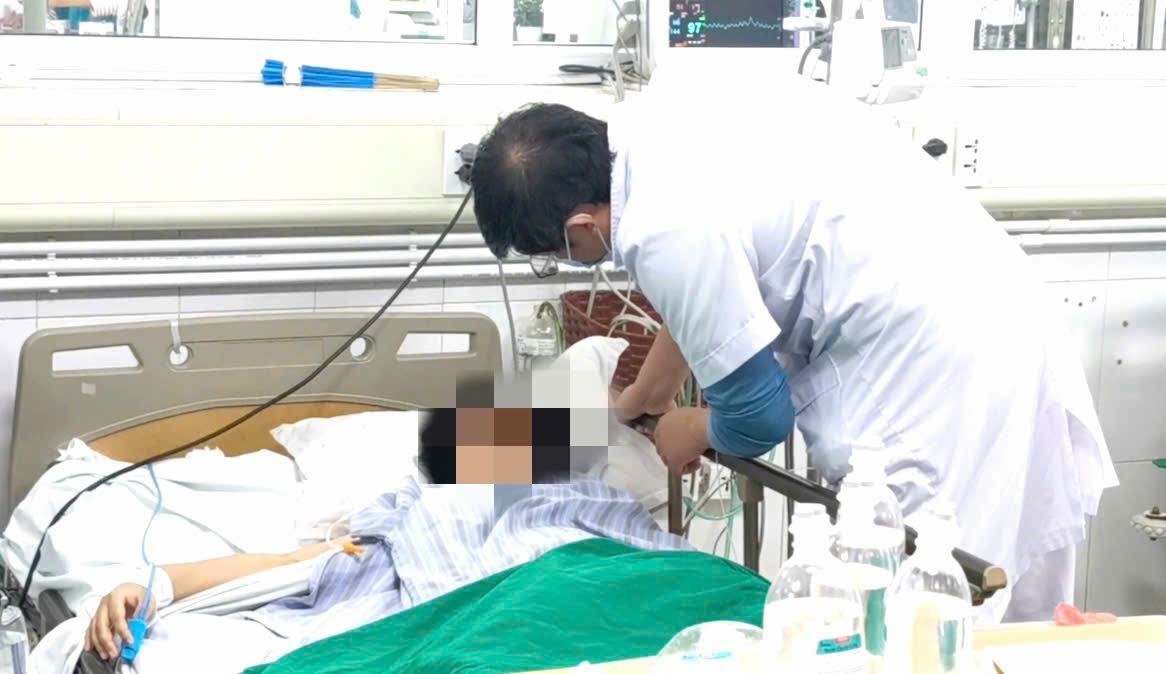
Seasonal changes of illness increase
In recent days, the North has entered the transitional season, with erratic weather changes that make the body easily tired and the immune system weakened. This is also the time when hospitals have recorded a rapid increase in the number of patients with respiratory diseases, seasonal flu, pneumonia, and sore throat, especially in the elderly and children - two groups with poor resistance and slower ability to adapt to changing weather than adults.
According to respiratory specialists, cold and humid weather is the ideal condition for viruses and bacteria to develop, while the human respiratory mucosa is easily dry and damaged. In the elderly, the reduced ability to dilate blood vessels and exchange gases makes the lungs function poorly, easily leading to pneumonia, bronchitis, and acute exacerbations of chronic obstructive pulmonary disease. In young children, the nasal mucosa is thin and does not have strong enough resistance, just exposure to cold air or drafts can easily cause flu, sore throat, tonsillitis, and even severe pneumonia.
Dr. Nguyen Thi Hoai An (An Viet Hospital) said: “When the weather turns cold, just a temperature difference of about 5-7°C between indoors and outdoors is enough to cause children to have rhinitis, cough, and even high fever. This is the body's natural reaction when the immune system has not yet adapted to environmental changes.”
For the elderly, prolonged coughs or colds, if not properly cared for, can quickly turn into pneumonia or cardiovascular attacks, which are life-threatening.
In addition to weather factors, living habits in the cold season also contribute to increasing diseases. Many people take late baths, set the air conditioner too cold, do not keep warm when sleeping or go out early in the morning. These seemingly small actions cause the body to suddenly get cold, reduce blood circulation and reduce resistance. People with colds often have symptoms of fever, headache, body aches - symptoms that make them seek out over-the-counter fever reducers, pain relievers, and flu medications to treat at home.
In this context, the need to use painkillers and fever reducers is understandable. However, subjectivity and the mentality of "using it to get well quickly" can cause a drug that is considered benign to become a silent threat to the liver and human health. From the story of changing seasons, cold weather and weakened resistance, another worrying issue is being raised: Paracetamol - the most familiar drug in the family medicine cabinet - can become "toxic" if used incorrectly.
When "good medicine" can become poison
Paracetamol (also known as acetaminophen) is the most popular pain reliever and fever reducer today. The drug is present in most products for treating colds, headaches, muscle aches, and is easily sold in pharmacies. Because of its convenience, Paracetamol is considered by many people as a "benign drug", which can be used whenever you feel feverish or tired. However, doctors warn: Paracetamol is a safe drug only when used in the right dose and at the right time. If abused or misused, it can become a "toxin" that attacks the liver - the body's most important detoxification organ.
According to Dr. Nguyen Trung Nguyen - Director of the Poison Control Center, Bach Mai Hospital, each year the center receives hundreds of cases of Paracetamol poisoning, of which more than 60% are due to self-treatment at home. Most patients do not know that, in addition to Paracetamol tablets taken directly, many types of cold medicines, fever reducers, cough suppressants, pain relievers, etc. also contain this active ingredient. When taken repeatedly, the total dose of Paracetamol taken into the body exceeds the safe threshold, causing the liver to not have time to metabolize and detoxify.
The toxic mechanism of Paracetamol is quite special. After absorption, most of the drug is metabolized by the liver into non-toxic substances. But about 5-10% is converted into NAPQI (N-acetyl-p-benzoquinonimine) - a highly toxic compound. Normally, the liver neutralizes NAPQI with glutathione, but when overdosed, the amount of glutathione in the liver is depleted, causing NAPQI to accumulate and destroy liver cells, leading to acute hepatitis, liver failure, and even hepatic coma if not treated promptly.
The danger is that in the first 24 hours, Paracetamol poisoning has almost no specific symptoms. The patient only feels tired, nauseous, and has no appetite - very similar to the symptoms of the flu. On the second or third day, when liver enzymes increase, the patient will experience pain in the liver area, yellow skin, yellow eyes, and by that time treatment is often too late. For people who regularly drink alcohol, have a poor diet, are weak, or are taking medication to treat tuberculosis or epilepsy - the risk of liver damage increases many times even when using only a normal dose of Paracetamol.
At the Poison Control Center - Bach Mai Hospital, many serious poisoning cases have been recorded. A 23-year-old female patient took 60 Paracetamol tablets in an effort to "quickly reduce fever" and fell into a state of acute liver failure, jaundice, and had to be treated intensively for many days. Others, just because they mixed the wrong dose for their relatives or used the same cold medicine and painkillers, had to be hospitalized because their liver enzymes increased dozens of times the normal level.
According to the Ministry of Health 's guidelines, the safe dose for adults should not exceed 3g of Paracetamol per day (equivalent to 6 tablets of 500mg) and for children it is 15mg/kg/time, maximum 6 times/day. However, doctors recommend using a lower dose, not lasting more than three days and absolutely not increasing the dose on your own. People who are using drugs containing Paracetamol should carefully check the packaging and avoid taking two drugs containing the same active ingredient at the same time.
When having a fever, instead of rushing to find medicine, people can apply safer physical measures such as: applying warm compresses to the armpits and groin, drinking plenty of water, loosening clothes, resting in a well-ventilated room, and monitoring body temperature. If the fever does not subside after 1-2 days or there are unusual symptoms such as fatigue, jaundice, pain in the liver area, you should see a doctor immediately.
Source: https://baolaocai.vn/paracetamol-thuoc-giam-dau-lanh-tinh-nhung-co-the-tro-thanh-doc-chat-post886271.html







![[Photo] Heavy damage after storm No. 13 in Song Cau ward, Dak Lak province](https://vphoto.vietnam.vn/thumb/1200x675/vietnam/resource/IMAGE/2025/11/08/1762574759594_img-0541-7441-jpg.webp)
































![[Video] Hue Monuments reopen to welcome visitors](https://vphoto.vietnam.vn/thumb/402x226/vietnam/resource/IMAGE/2025/11/05/1762301089171_dung01-05-43-09still013-jpg.webp)




































































Comment (0)